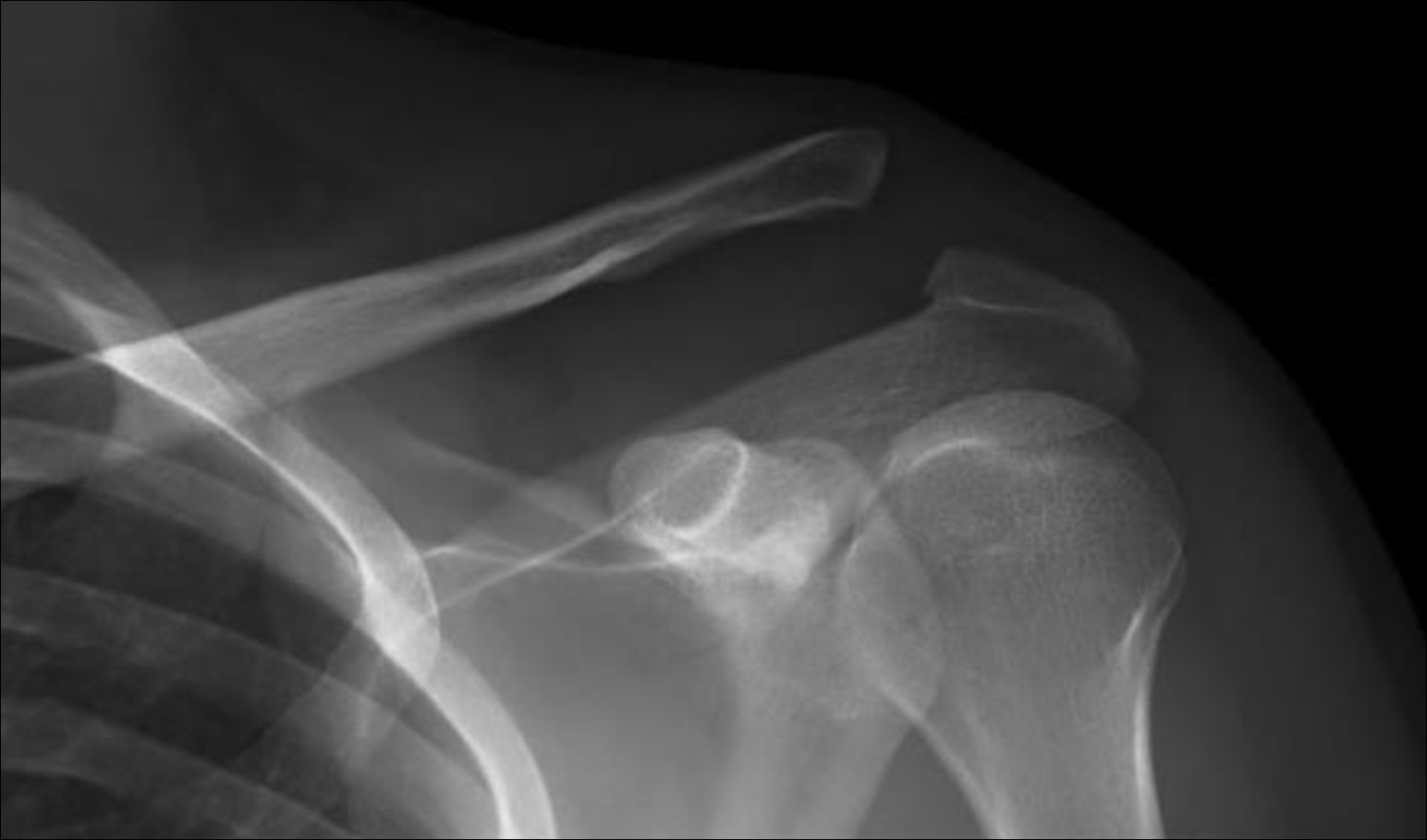Should we fix grade III AC joint injuries in athletes?
The acromioclavicular joint is a commonly injured joint in sports. Injury typically occurs from direct impact from a collision as in football or hockey or from a fall onto the shoulder with the arm adducted, which is a common occurrence in many recreational sports.
Grade I and II injuries are treated non-operatively. Grade IV, V and VI injuries are treated surgically. There is some controversy in the management of grade III injuries as to whether surgical or nonoperative management is best.
Case
A 24-year-old professional mountain biker fell onto his left shoulder, which is his dominant side. He was taken to the local medical facility near the mountain. His most significant finding was a deformity at his acromioclavicular (AC) joint. Radiographs demonstrate a grade III AC separation. How would you proceed in treatment?

AP radiograph of left shoulder demonstrates elevated clavicle at the acromioclavicular joint consistent with a grade III AC joint separation.
Source: McCarty E.
Discussion
Acromioclavicular joint injuries can be very painful. It is often challenging for the athlete to return to sports after a high grade AC injury (grade III or higher). When evaluating the athlete who has an injury similar to that this athlete, it is important to remember that other shoulder pathology can occur at the same time. Concomitant injuries are often masked by the more painful AC joint injury. In a series of 77 patients, more than 18% (14 patients) had intraarticular pathology with most of these being superior labrum anterior posterior (SLAP) lesions.

Eric McCarty
Arguments could be made for either operative or nonoperative treatment of this injury for this young competitive athlete. Traditionally, the initial treatment of these injuries has been nonoperative with the exception the consideration of surgery in a throwing athlete and/or a laborer. In a majority of these type of injuries, the patient will recover and have good function and minimal long-term symptoms. A waiting time of 12 weeks has been suggested and if no improvement is seen after that time, then operative stabilization would be offered. Additionally, the historical methods of surgical treatment did not demonstrate any great advantage in long-term outcomes over nonoperative management.
There are many factors that should be considered in this scenario of this young athlete. First, this athlete is highly competitive and requires significant upper extremity stamina and strength in order to control the mountain bike during the maneuvering in irregular terrain. Loss of the AC joint stability would potentially affect the upper extremity strength by its effect on the stabilization of the scapula. Next, there is potential that the AC joint remains painful, despite nonoperative management. With the demands on the athlete and potential washboard jarring during mountain biking, pain may be a real factor.
The next factor to consider is that this patient has a finite time to take off from riding and training. If he initially treats this without surgery and after 3 months finds he still has symptoms and surgery, then it will be a minimum of another 4 months before he can return to competitive riding after surgery. In this situation, it is reasonable to give the athlete the option of having surgery that will have a good chance of restoring the anatomy and stability of the coracoclavicular ligaments and a return to competition in 4 months vs. the risk of having the nonoperative route not work and having to wait 7 months or 8 months to return.
Lastly, the other factor to consider is that these injuries fixed in the acute setting have been shown to fare better than those fixed in a delayed manner. Beitzel and colleagues in a systematic review demonstrated 91% favorable outcomes in those patients with AC joint treated early with surgical management vs. 72% for those with a delay in surgery.
Factors to consider
In summary, there are many factors to consider. With current anatomic surgical techniques of treating this type of injury, I now consider fixing the grade III AC injuries more acutely in an athlete and have been pleased with the success. With the scenario above and current anatomic surgical techniques of repair and fixation what would you do?
- Would you even offer surgery acutely?
- If you would perform surgery acutely, would you reduce the clavicle with some type of fixation and let the tissue scar in? Or would you also augment with a graft?
- How long would you wait for surgery if treated initially nonoperatively?
Share your comments below.
References:
Beitzel K. Arthroscopy. 2013;doi:10.1016/j.arthro.2012.11.023.
Tischer T. Am J Sports Med. 2009;doi:10.1177/0363546508322891.
Eric McCarty, MD, is Chief of Sports Medicine and Shoulder Surgery and an associate professor in the Department of Orthopaedics at the University of Colorado.
Disclosure: McCarty receives royalties from Biomet.
